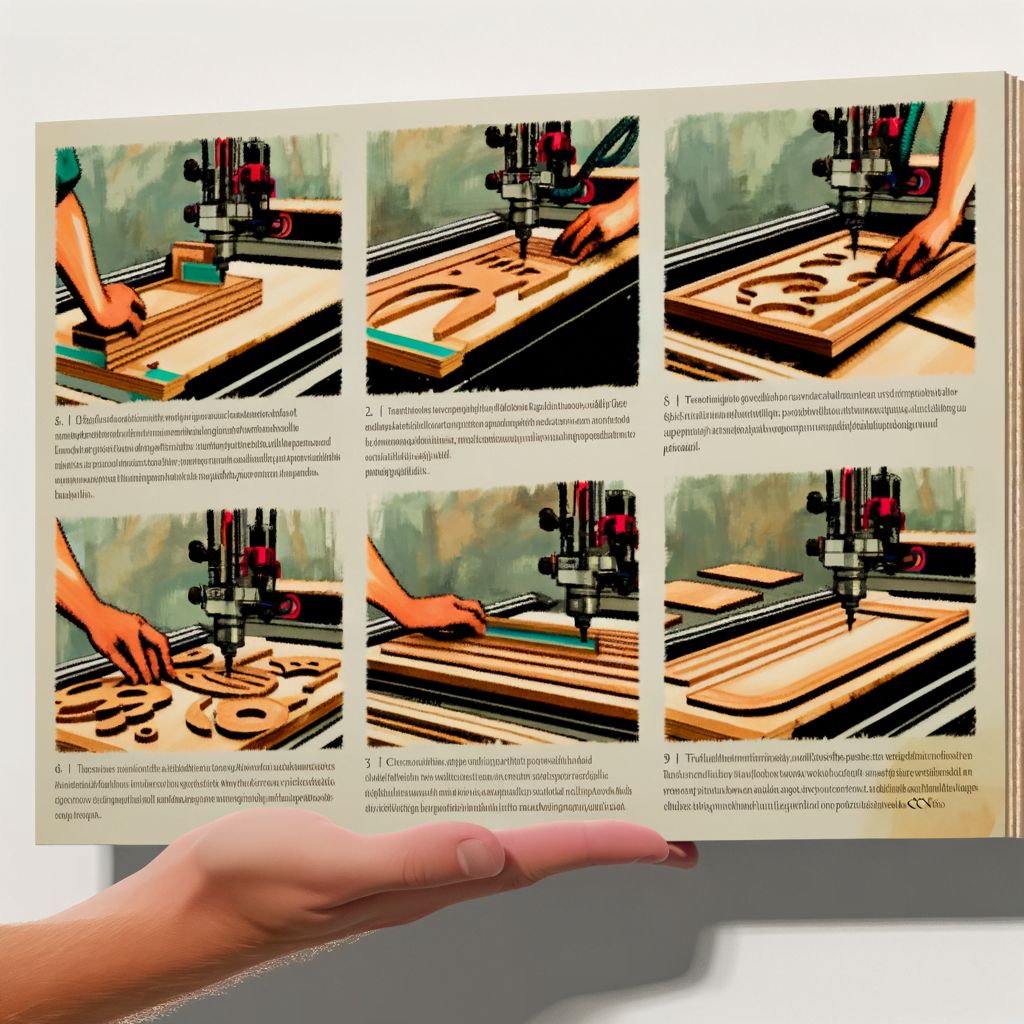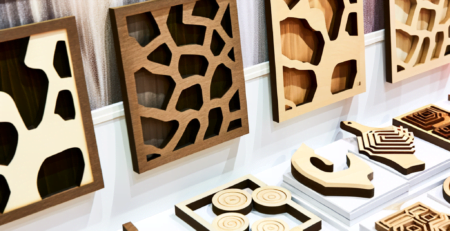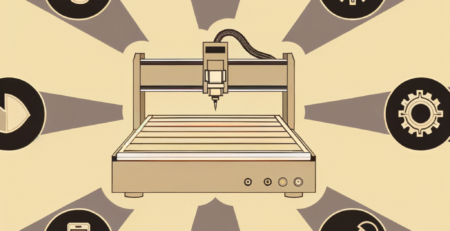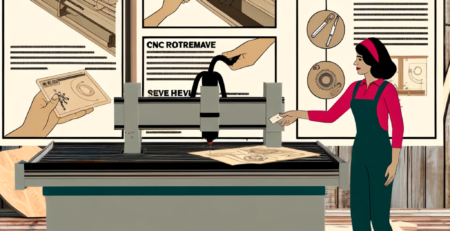Achieving Precision Cuts with Your CNC Router – Tips and Techniques
Tabla de contenido
“Mastering the Art of Precision: Elevate Your CNC Routing with Expert Tips and Techniques”
Introducción
Achieving precision cuts with a CNC router is essential for producing high-quality work in industries such as woodworking, metalworking, and plastic fabrication. The ability to execute precise cuts consistently not only ensures the integrity of the final product but also enhances efficiency and reduces material waste. To accomplish this level of accuracy, operators must understand the interplay between the CNC machine’s capabilities, tool selection, workpiece material, and the specific techniques employed during the cutting process. This introduction will explore various tips and techniques that can help operators optimize their CNC routing operations for the utmost precision and reliability. From understanding the importance of proper machine maintenance and calibration to selecting the right cutting tools and optimizing feed rates and spindle speeds, we will delve into the strategies that can lead to flawless cuts and exceptional finished products.
Mastering Tool Selection for Optimal CNC Router Performance
Achieving Precision Cuts with Your CNC Router – Tips and Techniques
In the realm of computer numerical control (CNC) routing, the quest for precision is paramount. The ability to execute flawless cuts with a CNC router not only depends on the machine’s capabilities but also on the operator’s expertise in selecting the right tools for the job. Mastering tool selection is critical for optimal CNC router performance, and understanding the nuances of this process can significantly enhance the quality of your work.
The first step in achieving precision cuts is to choose the correct cutting tool for the material you are working with. Different materials require different types of router bits. For instance, cutting hardwoods like oak or maple necessitates the use of a bit with sharp, durable cutting edges, such as carbide-tipped or solid carbide bits. Conversely, softer materials like foam or plastics may be better suited to single or double flute bits that evacuate chips effectively and reduce the risk of melting due to heat buildup.
Moreover, the geometry of the bit plays a crucial role in the quality of the cut. Spiral bits, for example, come in various configurations, including up-cut, down-cut, and compression spirals. An up-cut spiral is excellent for evacuating chips from the cut, which is ideal for deeper cuts in materials like wood. On the other hand, a down-cut spiral pushes the chips downward, creating a smooth finish on the top surface, which is beneficial when working with laminated materials. Compression spirals combine the best of both worlds, producing a clean cut on both the top and bottom surfaces, which is particularly useful for cutting plywood or veneered materials.
Furthermore, the number of flutes on a bit affects both the finish of the cut and the feed rate you can achieve. Single-flute bits are great for materials that require high feed rates and efficient chip removal. In contrast, bits with multiple flutes produce a finer finish but may require slower feed rates to prevent chip re-welding, especially in plastic or aluminum.
Another aspect to consider is the bit’s size and cutting diameter. Larger diameter bits can provide more stability and a smoother cut but may not be suitable for intricate details or smaller radius corners. Smaller diameter bits excel in detailed work but may not withstand the rigors of heavy cutting. Therefore, it is essential to balance the need for detail with the demands of the cutting operation.
Additionally, ensuring that your CNC router is running at the correct speeds and feeds is vital for achieving precision cuts. The speed of the router spindle and the feed rate at which the material is passed through the bit must be carefully calibrated. Running the router at too high a speed can lead to burning or melting the material, while too slow a speed can cause chipping or breakage of the bit.
Lastly, maintaining your tools is just as important as selecting the right ones. Dull or damaged bits can lead to poor cut quality and may even damage your CNC router. Regularly inspecting and replacing or sharpening your bits will help maintain the precision of your cuts and extend the life of your tools.
In conclusion, achieving precision cuts with your CNC router is a multifaceted endeavor that hinges on the judicious selection and maintenance of cutting tools. By understanding the properties of the materials you are working with, choosing the appropriate bit geometry and size, and fine-tuning your machine’s speeds and feeds, you can ensure that your CNC router operates at peak performance. With these tips and techniques, you can master the art of precision cutting, resulting in projects that stand out for their quality and craftsmanship.
Advanced Material Clamping Strategies for Precision CNC Routing

Achieving Precision Cuts with Your CNC Router – Tips and Techniques
In the realm of CNC routing, precision is paramount. The ability to execute flawless cuts with your CNC router not only depends on the machine’s capabilities but also on the strategies employed to secure the material in place. Advanced material clamping strategies are essential for ensuring that the workpiece does not move during the cutting process, which could lead to inaccuracies and potentially ruin the project.
One of the foundational steps in achieving precision cuts is selecting the appropriate clamping system. Traditional clamps, such as G-clamps and vice grips, can be effective but may not provide the most secure hold for intricate work. Instead, consider using vacuum pods or suction-based systems that offer a more uniform distribution of holding force across the workpiece. This method minimizes the potential for material movement and can accommodate a variety of shapes and sizes.
Moreover, it’s crucial to recognize the importance of the workpiece’s surface condition. A clean, flat surface enhances the effectiveness of vacuum clamps by ensuring a tight seal, thereby preventing any loss of suction during the routing process. Prior to clamping, it is advisable to clean both the workpiece and the machine bed thoroughly to remove any debris or residue that could compromise the hold.
Another technique to consider is the use of sacrificial boards or spoilboards. These boards are placed underneath the workpiece and serve multiple purposes. They protect the machine bed from damage, provide additional support to the material, and can be machined to create a perfectly level surface for the workpiece to rest upon. This is particularly beneficial when working with materials that are not perfectly flat or when the machine bed has slight imperfections.
In addition to these strategies, the use of custom jigs and fixtures can be a game-changer for achieving precision cuts. Jigs and fixtures are designed to hold the workpiece in a specific orientation and are particularly useful for repetitive cuts or when working with irregularly shaped materials. By creating a tailored support system, you can ensure that the material is held securely and consistently, which is critical for maintaining accuracy throughout the production run.
Furthermore, it’s essential to apply the correct amount of clamping force. Too much force can cause deformation or damage to the material, while insufficient force can lead to slippage during the cutting process. It’s a delicate balance that requires careful consideration of the material’s properties and the specifics of the project at hand.
Lastly, it’s important to regularly inspect and maintain your clamping equipment. Wear and tear can affect the performance of clamps and fixtures over time, leading to a gradual decline in precision. Regular maintenance checks and timely replacements can prevent such issues from impacting the quality of your cuts.
In conclusion, advanced material clamping strategies are a critical component of precision CNC routing. By carefully selecting the right clamping system, ensuring a clean and flat work surface, utilizing sacrificial boards, designing custom jigs and fixtures, applying the correct clamping force, and maintaining your equipment, you can significantly enhance the accuracy and quality of your CNC routed projects. These techniques, when implemented effectively, can make the difference between a mediocre outcome and a masterpiece of precision craftsmanship.
Implementing Effective CNC Router Speeds and Feeds for Clean Cuts
Achieving Precision Cuts with Your CNC Router – Tips and Techniques
In the realm of computer numerical control (CNC) routing, the quest for precision and cleanliness in cuts is paramount. The quality of the finished product is often a direct reflection of the care taken in setting up and executing the cutting process. Implementing effective CNC router speeds and feeds is crucial for achieving clean cuts, and there are several tips and techniques that can help operators ensure their work meets the highest standards of precision.
Firstly, understanding the relationship between speed and feed rate is essential. The speed of a CNC router refers to the rate at which the spindle rotates, typically measured in revolutions per minute (RPM). The feed rate, on the other hand, is the speed at which the cutting tool advances through the material, measured in inches per minute (IPM) or millimeters per minute (MMPM). Striking the right balance between these two parameters is critical for clean cuts. If the spindle speed is too high or the feed rate too low, the tool may burn or melt the material, leading to poor quality cuts. Conversely, if the spindle speed is too low or the feed rate too high, the tool may cause chipping or splintering.
To achieve optimal results, it is advisable to start with the manufacturer’s recommended settings for the specific material and tool being used. These recommendations provide a solid foundation, but fine-tuning may be necessary to account for variables such as tool wear, material inconsistencies, and machine idiosyncrasies. It is often beneficial to conduct test cuts on scrap material to dial in the perfect settings before moving on to the final workpiece.
Another technique to ensure clean cuts is to select the appropriate cutting tool for the job. Different materials and cut types require specific tools designed to handle the task. For instance, using a single-flute end mill may be ideal for cutting plastics to reduce heat generation, while a multi-flute end mill might be better suited for metals to increase cutting efficiency. The condition of the tool is also paramount; a dull or damaged tool can lead to rough cuts and should be replaced or sharpened.
Moreover, the importance of maintaining a stable and secure workpiece cannot be overstated. Any movement during the cutting process can result in imprecision and potentially ruin the cut. Utilizing proper clamping techniques and ensuring that the material is flat and well-supported will minimize vibrations and deflections that can compromise cut quality.
Additionally, implementing climb milling, where the cutter rotates in the same direction as the feed, can result in a cleaner edge finish compared to conventional milling. This method reduces the chance of tear-out on the material, but it requires a well-maintained machine with minimal backlash to prevent the cutter from pulling into the workpiece.
Lastly, it is essential to monitor the cutting process and be prepared to make adjustments on the fly. Factors such as changes in material density or the presence of knots in wood can affect how the tool interacts with the material. Being attentive and responsive to these changes can help maintain the quality of the cut throughout the entire process.
In conclusion, achieving precision cuts with a CNC router is a matter of meticulous setup and careful execution. By implementing effective speeds and feeds, selecting the right tools, securing the workpiece, and being attentive to the cutting process, operators can ensure that their cuts are clean and precise. With practice and attention to detail, the CNC router becomes an invaluable tool for producing high-quality work that meets the exacting standards of today’s industries.
Conclusión
Conclusión:
Achieving precision cuts with a CNC router requires a combination of proper machine setup, tool selection, and cutting strategy. Ensuring that the CNC router is well-maintained and calibrated is fundamental to precision. Using the correct cutting tools for the material and job, and keeping them sharp, is essential. Employing appropriate feed rates, spindle speeds, and pass depths can significantly improve cut quality and accuracy. Additionally, securing the workpiece firmly and using jigs or templates when necessary can prevent material movement and enhance precision. By following these tips and techniques, operators can consistently produce precise and high-quality cuts with their CNC routers.





Deja una respuesta